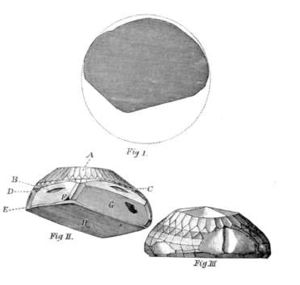كوهينور
 Glass replica of the Mountain of Light Diamond after its first cut. From the Reich der Kristalle museum in Munich. | |
| الوزن | 105.602 carats (21.1204 g) |
|---|---|
| منجم المنشأ | Kollur Mine, Andhra Pradesh, India[1] |
| القطع | Hortenso Borgia |
| المالك الأصلي | Kakatiya dynasty |
| المالك الحالي | Part of the Crown of Queen Elizabeth (see British Crown Jewels) |
جبل النور أو كوهِ نور أو كوهينور is a diamond that was mined at Kollur Mine, in the present state of Andhra Pradesh in India. It was originally 793 carats when uncut.[2] Once the largest known diamond, it is now a 105.6 metric carat diamond, weighing 21.6 grammes in its most recent cut state. The diamond was originally owned by the Kakatiya dynasty, which had installed it in a temple of a Hindu goddess as her eye.[3] The diamond changed hands between various feuding factions in the region several times over the next few hundred years.[4] In 1852, Albert the Prince Consort ordered it cut down from 186 carats. Today the diamond is a part of the Crown of Queen Elizabeth (see British Crown Jewels).[5]
التاريخ


استيلاء الفرس عليها

Following the invasion of Nader Shah, the Shah of the Persian Empire, in 1739 and the Battle of Karnal which led to the sacking of Agra and Delhi, the treasury of the Mughal Empire was looted by Nader Shahs army in an organised and thorough acquisition of the Mughal nobilities wealth. Along with a host of valuable items, including the Daria-i-Noor as well as the Peacock Throne, he also carried off the Koh-i-Noor to Persia in 1739. It was allegedly Nāder Shāh who exclaimed Koh-i-Noor! when he finally managed to obtain the famous stone,[4] and this is how the stone gained its present name. There is no reference to this name before 1739.
استيلاء البريطانيين عليها
Maharaja Ranjit Singh was the founder and ruler of the Sikh Empire based in the Punjab region. He willed the diamond to the Hindu temple of Jagannath in Puri, in modern day Odisha, India.[7][8] However, after his death in 1839 the British East India company did not execute his will.[9] On 29 March 1849, the British raised their flag on the citadel of Lahore and the province of Punjab was formally proclaimed part of the British Company rule in India.

المعرض الكبير
الجمهور البريطاني سنحت له الفرصة لمشاهدة كوهينور حين أقيم المعرض الكبير في هايد پارك، لندن في 1851.
جواهر التاج

انظر أيضاً
الهامش
- ^ http://www.minelinks.com/alluvial/diamonds_1.html
- ^ "Fascinating History of World Best Diamonds". The Northern Star. Lismore, NSW: National Library of Australia. 30 May 1953. p. 6. Retrieved 31 August 2013.
- ^ أ ب ت Deccan Heritage, H. K. Gupta, A. Parasher and D. Balasubramanian, Indian National Science Academy, 2000, p. 144, Orient Blackswan, ISBN 81-7371-285-9
- ^ أ ب Iradj Amini, ed. (July 20, 2002). "KOH-I-NOOR". United States: Encyclopædia Iranica – Online Version. Retrieved 2012-08-22.
- ^ http://www.bbc.com/news/uk-politics-21623965
- ^ "Large And Famous Diamonds". Minelinks.com. Retrieved 2009-08-10.
- ^ Ethnic Tensions in Indian Society: Explanation, Prediction, Monitoring, and Control, p. 145, في كتب گوگل
- ^ http://www.huffingtonpost.co.uk/2013/02/21/koh-i-noor-diamond-not-returned-india-david-cameron-insists-pictures_n_2732342.html
- ^ خطأ استشهاد: وسم
<ref>غير صحيح؛ لا نص تم توفيره للمراجع المسماةindia-claim - ^ خطأ استشهاد: وسم
<ref>غير صحيح؛ لا نص تم توفيره للمراجع المسماةBritannica
المصادر
- Streeter, Edwin: The Great Diamonds of the World. "Famous Diamonds: Koh-i-Nur, Great Diamond of History & Romance". Farlang.com. p. 109. Retrieved 2009-08-10.
- Tavernier: Travels in India II (Koh-i-Noor?) http://www.farlang.com/diamonds/tavernier-travels-india-2/page_068
- Abul Fazal: Akbarnama. Translated into English by Henry Beveridge.
- Tavernier, Jean-Baptiste: Travels in India. Translated into English by Valentine Ball and William Crooke
- Tavernier's discussion on the Diamond in Appendix I
- The archives of The Times.
- Photograph of Koh-i-Noor Diamond-cource. Government of UK
- Rushby, Kevin (2004). Chasing the Mountain of Light: Across India on the trail of the Koh-i-Noor diamond. London: Robinson. ISBN 1-84119-882-X.
- C Kinsey, Danielle (April 2009). "Koh‐i‐Noor: Empire, Diamonds, and the Performance of British Material Culture". Journal of British Studies. 48 (2): 391–419. doi:10.1086/596104. Retrieved 19 November 2015 – via JSTOR.
- Prasad G (1988). History of the Andhras up to 1565. P. G. Publishers, Guntur.
وصلات خارجية
- Evelyn Martinengo-Cesaresco "The Folk-Lore Journal. Volume 4/A Story of the Koh-i-Nûr" The Folk-Lore Journal. Volume 4, pp. 252–4.
- The World of Famous Diamonds
- The Kohinoor Diamond Story
- History of the Kohinoor
- The Koh-i-noor Diamond on h2g2
- [1]


